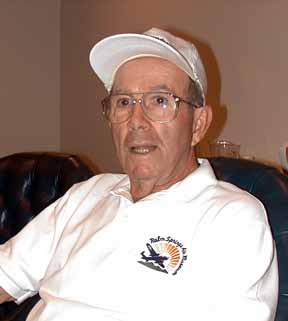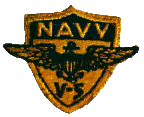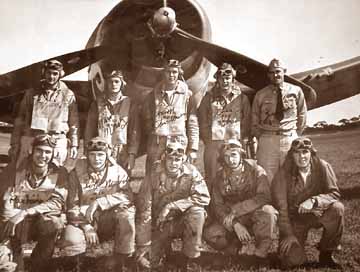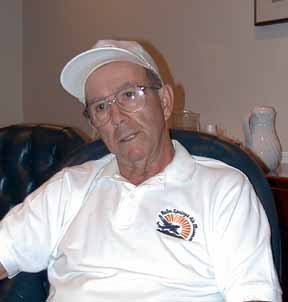Hal Staub
Corsair Pilot

Webmaster: When were you born?
November 9, 1921
Webmaster: Where was that?
Glendale, California
Webmaster: You grew up there?
Grew up and lived there, other than my service time, until 1969. I attended Hoover High School in Glendale graduating in January of 1940.
Webmaster: Where did you attend college?
USC.
Webmaster: Was the draft a problem while you were in college?
No, I joined the Navy a matter of weeks after Pearl Harbor. At that time, I had nearly two years of college and the Navy let me finish my current semester.
Webmaster: When you joined the Navy, was it with the intention of flight school?
Yes, I joined the V-5 program which was Naval Cadet School. In June of 1942 I was sent to Prescott, Arizona and I entered the flight training program run by Glendale College and learned to fly in a Porterfield which is similar to a Cub. This was at Love Field in Prescott. Glendale College was under contract to the Navy to train beginning pilots. We wore khaki uniforms with a Navy V-5 emblem on it.
When I finished the program there, I had half a dozen flights in a Ryan Recruit that was also available. More experienced pilots started out in the Ryan but I was a beginner so started in the Porterfield.
 Webmaster: How many hours did you get in the Porterfield during this V-5 program?
Webmaster: How many hours did you get in the Porterfield during this V-5 program?
About 25 hours.
Webmaster: After Prescott, where did you go?
Del Monte Hotel, Monterey, California for preflight school. I was in the first battalion. This hotel had been a luxury hotel and still had the lush, red carpeting. Except instead of one to a room, we had six to a room. We were now in the Navy under military discipline.
Webmaster: This was the fall of 1942 and preflight lasted three months?
Yes, three months of athletics, radio, code, navigation, weather and other flight related schooling. The athletics consisted of mostly organized sports like football. Since I had played football at USC, I played football and boxing in Monterey.
Webmaster: You played football at USC? Who were your coaches?
Gaius Shaver was my freshman coach and Howard Jones. Jones died during the summer.
Webmaster: What position did you play?
Halfback. Howard Jones liked big players and that worked against me. Jones told Shaver not to spend much time on me because I was too small. I broke my ankle which ended my questionable football career.
Webmaster: You must have been fast?
Not really fast but I could keep up.
Webmaster: In preflight, you didn't fly but learned military decorum.
Yes, and a lot of physical activity. They had us running in two feet of surf. That will really tire you out.
Webmaster: After preflight where did you go?
Norman, Oklahoma to fly Stearmans. I had a ball there. Flying Stearmans made you feel like the Red Baron. Tex Beneke was our base band. His was a terrific Glen Miller band. One night a week, he and I played pool.
Webmaster: Flying the Stearman, you really learned how to fly. How many flight hours did you log?
I can't remember exactly but I would guess about two hundred.
Webmaster: Did you do any inverted spins?
No, we did falling leaves, snap rolls, slow rolls, loops and other aerobatics.
Webmaster: It was winter and cold in Norman, Oklahoma and you were in an open cockpit?
Yes, Norman is not the place to spend the winter. It was cold. Let me give you an example. One time we were up and the weather was really getting bad. I returned to the field and my ground speed upon landing was not more than five miles an hour the wind was so heavy. Cadets were all lined up to grab our wings. Some planes flipped over and there were injuries.
Webmaster: This primary lasted how long?
Three or four months. From primary we went to either Corpus Christi or Pensacola. I went to Corpus Christi. There we flew Vultee Vibrators similar to the SNJ.
Webmaster: Was that an SNV?
Yes, it was slower and a bit smaller than the SNJ. While still in Corpus, I went down to Kingsville which is part of Corpus Christi and flew SNJ's there and learned fighter tactics.
Webmaster: The SNJ had a gun?
Yes, it fired through the propeller and sometimes into it.
Webmaster: When you graduated from Corpus Christi, you became an officer?
Yes, prior to that as cadets, we were at the bottom of the barrel.
Webmaster: And reminded of that daily?
Yes, I received my Navy Wings and became an ensign.
Webmaster: By now, you had around five hundred flying hours which is a lot more than the enemy had when they graduated their pilots?
Yes, we had a lot more hours training time.
Webmaster: At this point, when you graduated, this is when you discover your permanent assignment?
Yes, and at that point I received orders to go to Melbourne, Florida which was strictly fighters. They had F4F's and F6F's. The moment I arrived at Melbourne, passing through the gate, an F4F was taking off and his Curtis electric prop shorted and went into high pitch on takeoff. He went in and was killed hitting some homes and killing several people on the ground. That was my introduction to Melbourne and I was not pleased to learn I was assigned to an F4F squadron. Within a month, I was happily upgraded to F6F's and I really enjoyed them.
Webmaster: You trained in combat at Melbourne?

Yes, you saw that picture of me along with some other guys in front of an F6F. The three instructors in that picture had been in the Pacific. Two were aces. We got a lot of dog fighting and air combat instruction. We were trained in the Thatch Weave and a lot of gunnery. Our targets were sleeves towed by other airplanes over the ocean.
We flew eight hours a day stopping at a nearby sandbar to gas up our planes. That sandbar eventually became Cape Canaveral.
Webmaster: How long did this training last?
About three months, every day, seven days a week 7-8 hours a day.
Webmaster: Had you done any carrier work yet?
We were doing field carrier landings. This is a strip on land marked with the carrier boundaries and a Landing Signal Officer.
Webmaster: Cables and all?
No cables. But they paid attention to where you touched down. We had a lot of these landings.
Webmaster: I understand you had to make seven actual carrier landings to qualify, is that true?
That's right. This was our next step. Quite a few of the guys went to the Great Lakes and trained on carriers in Lake Michigan using SNJ's. My first real carrier landing was on a jeep carrier with a Corsair. This occurred after I joined my Corsair squadron.
After I left Melbourne, I was assigned to a Corsair squadron at the Naval Air Station, Atlantic City.
Webmaster: How did they check you out in the Corsair?
They gave me a handbook and it was a hairy day. I went out and sat in the cockpit and went through the handbook for maybe an hour. My first takeoff in a Corsair was accompanied by my instructor flying a second Corsair. This was an area familiarization flight to acquaint me with the surroundings. We were flying in formation and the weather closed in and we had a hell of a time getting back. We had to fly along the highway at about fifty feet. We made three passes over the field before we could see well enough to land. Being my first flight, I stayed very close to him and we landed in formation.
Webmaster: How long were you in Atlantic City?
Quite awhile. We were in a special squadron of which there were only two. VOF1 and VOF2. We were VOF2. We were trained as a fighter squadron and half way through that training, we were trained as an observation squadron. We went to Fort Sill, Oklahoma and trained with the Army spotting with big guns. We also trained with the Navy spotting for the big guns on battleships and cruisers.
From Atlantic City, we were assigned to a carrier that brought us into the Pacific to Okinawa. Our carrier pulled up about 50 miles from Okinawa about two weeks before the invasion. We would then fly into Okinawa and I was assigned to work with various ships and spot their targets. This required that we fly at ground level. We also carried napalm, bombs, rockets and ammo for our guns in order to help take out these targets if I couldn't get the ship in on it.
Webmaster: What was your carrier?
Fanshaw Bay, a jeep carrier CVE-70. Early on, we had Frogmen in the water and our job was to keep the guns on the coast silent. We strafed the beaches and anytime they would open up on our frogmen, we would go in and silence them.
Webmaster: You said you were in VOF2?
Yes, we were originally scheduled to go to Normandy but they switched us and VOF1 went to Normandy to spot for the D-Day invasion and we went to the Pacific.
Webmaster: I had no idea we had Corsairs at Normandy?
Yes, they were doing the same thing we did. That is spotting for the big ships. Spotting was dangerous duty because you flew alone and close to the ground. As an example, we took four Marine pilots from Eniwetok to Okinawa. They flew small spotter planes just a bit larger than a J3 Cub. They stayed aboard ship until the day of the invasion. They were all shot down the first day. Flying those small, slow planes made them sitting ducks.
At Okinawa we did a lot of strafing, a lot of rocket work. I got my first DFC on my third day at Okinawa. A gun placement opened up on US Frogmen and we couldn't spot them. There were four of us looking for this anti-aircraft gun and we were getting hit. I didn't know any other way to spot this gun so I made a dive on it so the other three could see where the bullets were coming from and it worked. My companions then dove on the spot and took it out.
Webmaster: Was this a battery of guns?
Yes, it was coming out of the jungle so we couldn't actually see the guns--just the area the bullets were coming from.
Webmaster: I've seen pictures of Corsairs all shot up but still flying?
They were just unbelievable. I got hit by a large round in the wing and it knocked a hole 2 1/2 feet in diameter. The plane flew as well as it ever had. We returned to the ship and they wouldn't let me land. They were afraid when I slowed down to land, I would lose control. Fortunately this was a week after the invasion and we had secured a landing strip called Yantan.
Webmaster:Was there much difference between one Corsair and another?

No, we rarely flew the same plane two days in a row. They would get beat up and were often being repaired. The carrier catapult, along with enemy fire, beat them up pretty bad so it would have been difficult to fly the same plane without sitting around waiting for it to be fixed.
Webmaster: We used hydraulic catapults in that war. I understand we could get more planes in the air using a regular deck run?
No, we could get more planes up with the catapults than we could doing deck takeoffs. With the CVE, you couldn't get enough planes on the deck for rapid deck takeoffs. As I remember, we could catapult a plane every twenty seconds. We landed every seventeen seconds.
Webmaster: When I am told that we could get more planes in the air with deck takeoffs, that would be referring to the big carriers?
Yes, that would probably be the case.
Webmaster: Once you were committed to land, could you still go around?
No, it was a cardinal sin to hit that throttle once the Landing Signal Officer (LSO) gave you the cut. If you hit the throttle after the cut, you would end up going over the side and/or killing some people on the catwalk.
Webmaster: I understand you can do that today but in your day, you did not have that option?
That is correct, you can do it today but we couldn't. At the point you get the cut from the LSO, all you can see is one little corner of the deck where he is standing. At that point, you are carrying about 85% of the throttle and hanging on the prop. When you see the cut, your action is to relax and yank the throttle back. Landing is now out of your hands and you hit like a rock. There are no smooth landings.
Webmaster: You had a visibility problem seeing straight ahead while landing a Corsair?
You couldn't see the deck from any plane at the point of the cut. The Wildcat, Hellcat, TBF, SBD or any of them had the same restricted visibility. When I hear people say that the Corsair was a bad carrier plane because of the restricted landing visibility due to the long nose, it was the same for all the planes.
Without the LSO, you are in trouble. When he gives you a cut, you better darn well take it. It is up to him. If the deck is in the wrong spot, coming up or down, you must rely on him to make the decision. You may have made a good approach but if he waves you off, you go full throttle and go around.

Webmaster: At what point during the invasion did you encounter the Kamikaze?
To be honest with you, I never saw a Kamikaze out where our ship was. We were further away than a lot of the ships. The Kamikaze came after those ships that were nearer. This happened at the beginning of the invasion.
I might add that prior to the invasion, we started dropping leaflets advising civilians to get above a particular parallel. We told them we would protect them and they would not be harmed. Some of them took our advice but not many.
The day that I had to land at Yantan, which was about a week after the invasion, I had just landed and was standing on the wing of my plane speaking with the enlisted man who just chocked my plane. All of a sudden this guy drops to the ground. He had been hit in the head by a sniper.
They took me and set me up with a bunk in a tent. I had just barely gotten settled in when half a dozen Kamikazes came in. The sky turned black from our anti-aircraft fire at these six planes. And within a matter of seconds, all six of them were knocked down. They were almost to Buckner Bay where all our ships were.
We left Okinawa twice. They sent us down to a little island just north of Formosa. A lot of the Kamikazes were coming from there. We weren't the first squadron in there but we were assigned to destroy as many as we could and make sure none got off the ground. We lost two of our pilots to ground fire. I don't know about the mentality of the Japanese. When somebody ordered them to do something, unless the order was rescinded, they kept doing it come hell or high water.
Webmaster: Even if it didn't work?
Even if it didn't work. As a result, one day a bunch of them were trying to take off and as each lifted off the runway and was up about 50 feet, we would go in and splash them but they just kept coming. It was like shooting ducks in a rain barrel. They kept coming, one after another, and we took turns taking them out one after another and they still kept coming. We were getting our rear ends shot off from ground fire so maybe these Kamikazes were just bait.
Webmaster: Was the Kamikaze a specific airplane or did they just load up whatever they had?
They used anything they had that they could put an inexperienced pilot in and a load of explosives.
Webmaster: Did any of the Kamikazes have guns.
I don't think so. None ever shot at me.
Webmaster: Back to Okinawa, the invasion is over and this is the summer of 1945. It was not long after that, we dropped the bombs. Where were you when this happened?
I was on a carrier one or two days out of Okinawa on our way home.
Webmaster: You were on your way home. So you were not going to be in on the invasion of the mainland, should that have been necessary?
No, we were going to get 30 days leave. After that, of course, they could have dispatched us into different squadrons and return us to the Pacific. But, as we know, that didn't happen.
Webmaster: The Japanese surrendered on August 15, you were home?
Yes, I was.
Webmaster: Did you stay in the Navy?
Yes, after my 30 day leave, I reported to Jacksonville, Florida.
Webmaster: What rank are you now?
A full lieutenant. At Jacksonville, I was a test pilot testing questionable airplanes to make sure they were capable of flying across the country to their respective graveyards in Oklahoma or Arizona. This allowed me to fly practically every single engine plane in the Navy.
Webmaster: It sounds like you had a lot of fun?
It was great because I got to fly everything. All the way through, I was in the right place at the right time.
Webmaster: Earlier you said you got your first DFC for setting yourself up as a target so your squadron could take out those guns. What was your second DFC for?
 The Japanese had a land-launched torpedo. I had never heard of one before or after. But I saw them bringing this on rail from a big cave to launch in Buckner Bay at our ships. I was in radio contact with our ship at the time and I told them what I though it was and what they were doing with it. Three or four of our ships pulled up anchor and got out of the way. Using rockets, I went in and blew it up. For that, I got my second DFC.
The Japanese had a land-launched torpedo. I had never heard of one before or after. But I saw them bringing this on rail from a big cave to launch in Buckner Bay at our ships. I was in radio contact with our ship at the time and I told them what I though it was and what they were doing with it. Three or four of our ships pulled up anchor and got out of the way. Using rockets, I went in and blew it up. For that, I got my second DFC.
Webmaster: Now the war is over and you are back in Jacksonville. Did you stay in the Navy?
I was in Jacksonville for three months and then my orders came for my separation.
Webmaster: You weren't recalled for Korea?
No, I wasn't.
Webmaster: This has been a long interview, thank you for your time, Hal, and thank you for your service to our country.



|